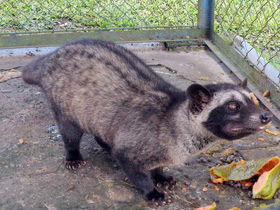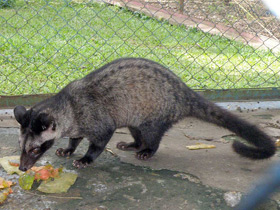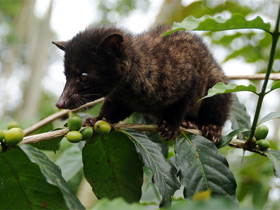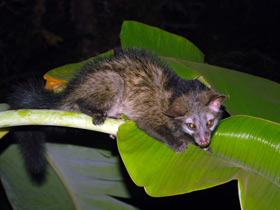The Asian palm civet or palm civet, toddy cat and musang (Paradoxurus hermaphroditus)
Asian palm civet видео
The Asian palm civet (Paradoxurus hermaphroditus), also called common palm civet, toddy cat and musang, is a viverrid native to South and Southeast Asia. Since 2008, it is IUCN Red Listed as Least Concern as it accommodates to a broad range of habitats. It is widely distributed with large populations that in 2008 were thought unlikely to be declining. In Indonesia, it is threatened by poaching and illegal wildlife trade; buyers use it for the increasing production of kopi luwak.
Habitat area
Paradoxurus hermaphroditus is a species of carnivorous mammal in the family Viverridae.
One of the most widely distributed civets, Paradoxurus hermaphroditus is found throughout South and Southeast Asia. Its range includes India, Sri Lanka, southern China, including Hainan Island, as well as all of mainland Indochina and numerous islands, including Sumatra, Borneo, Java and the southern Philippines. Paradoxurus hermaphroditus inhabits tropical rainforests, but in some regions it has adapted to live close to humans and may take up residence in attics and barns and damage coffee plantations.
Appearance
Paradoxurus hermaphroditus has a hard, dense grey coat with black stripes on the back, which develop into individual patches on the shoulders and sides. The legs, ears and muzzle of Paradoxurus hermaphroditus are black, with white patterns on the muzzle. The epithet hermaphrodite has been given to this species because of its scent-producing testicular glands, present in both sexes. Paradoxurus hermaphroditus is 48-59 cm long, with a tail length of 44-54 cm, and weighs between 2.5 and 4 kg.
Nutrition
Like most wyverns, Paradoxurus hermaphroditus is exclusively active at night. It spends most of its time in trees and is able to climb well. During the day, palm civets sleep in branch forks or hollow trees. They are omnivorous, with a diet ranging from rodents, small birds, insects, worms and bird eggs to fruits (especially mangoes and bananas).
Reproduction
Outside the breeding season, Paradoxurus hermaphroditus lead a solitary life. After a gestation period of 60 days, the female gives birth to two to five cubs in a hole, which are fed with milk for one year. In captivity, Paradoxurus hermaphroditus can live up to 25 years.
Figures 1 and 2 show coffee seeds that have passed through the digestive tract of Paradoxurus hermaphroditus.
Conservation
Paradoxurus hermaphroditus is listed on CITES Appendix III. There is a quota in place in Indonesia, precluding trade from certain areas, setting a cap on the number of civets that can be taken from the wild, and allowing only 10% of those removed from the wild to be sold domestically. This quota is largely ignored by hunters and traders and is not enforced by authorities. This species has become popular as a pet in Indonesia in recent years, causing a rise in the numbers found in markets in Java and Bali. The majority of the animals sold as pets originate from the wild. The high numbers of animals seen, lack of adherence to the quota and lack of enforcement of the laws are causes for conservation concern.
Taxonomy
ItViverra hermaphrodita was the scientific name proposed by Peter Simon Pallas in 1777. It is the nominate subspecies and ranges in Sri Lanka and southern India as far north as the Narbada River. Several zoological specimens were described between 1820 and 1992:
- Viverra bondar by Anselme Gaëtan Desmarest in 1820 was a specimen from Bengal;
- Viverra musanga by Stamford Raffles in 1821 was a specimen from Sumatra;
- Viverra musanga, var. javanica by Thomas Horsfield in 1824 was a specimen from Java;
- Paradoxurus pallasii by John Edward Gray in 1832 was a specimen from India;
- Paradoxurus philippinensis by Claude Jourdan in 1837 was a specimen from the Philippines However, a genetic study in 2015 reclassifies it as a separate species;
- Paradoxurus philippinensis by setosus by Honoré Jacquinot and Pucheran in 1853;
- Paradoxurus philippinensis by nictitans by Taylor in 1891 was a specimen from Odisha;
- Paradoxurus philippinensis by lignicolor by Gerrit Smith Miller Jr. in 1903;
- Paradoxurus philippinensis by minor by John Lewis Bonhote in 1903;
- Paradoxurus philippinensis by canescens by Lyon in 1907;
- Paradoxurus philippinensis by milleri by Cecil Boden Kloss in 1908;
- Paradoxurus philippinensis by kangeanus by Oldfield Thomas in 1910;
- Paradoxurus philippinensis by sumbanus by Ernst Schwarz in 1910;
- Paradoxurus philippinensis by exitus by Schwarz in 1911;
- Paradoxurus philippinensis by cochinensis by Schwarz, 1911;
- Paradoxurus philippinensis by canus (Miller, 1913);
- Paradoxurus philippinensis by pallens (Miller, 1913);
- Paradoxurus philippinensis by parvus (Miller, 1913);
- Paradoxurus philippinensis by pugnax (Miller, 1913);
- Paradoxurus philippinensis by pulcher (Miller, 1913);
- Paradoxurus philippinensis by sacer (Miller, 1913);
- Paradoxurus philippinensis by senex (Miller, 1913);
- Paradoxurus philippinensis by simplex (Miller, 1913);
- Paradoxurus philippinensis by enganus by Lyon, 1916;
- Paradoxurus philippinensis by laotum by Nils Carl Gustaf Fersen Gyldenstolpe in 1917 was a specimen from Chieng Hai in north-western Thailand, and ranges from Myanmar to Indochina and Hainan;
- Paradoxurus philippinensis by balicus by Sody in 1933 was a specimen from Bali;
- Paradoxurus philippinensis by scindiae by Pocock in 1934 was a specimen from Gwalior, and ranges in central India;
- Paradoxurus philippinensis by vellerosus by Pocock in 1934 was a specimen from Kashmir;
- Paradoxurus philippinensis by dongfangensis by Corbet and Hill in 1992;
- The taxonomic status of these subspecies has not yet been evaluated.
In mythology
In Philippine mythology, the Bagobo people believe a being named Lakivot was said to be a huge and powerful palm civet who can talk. Lakivot defeated various monsters, including the one-eyed monster Ogassi and the busaw beings who guarded the Tree of Gold, which had the Flower of Gold that he sought. He was eventually transformed into a handsome young man, and married the person to whom he gave the Flower of Gold.













































